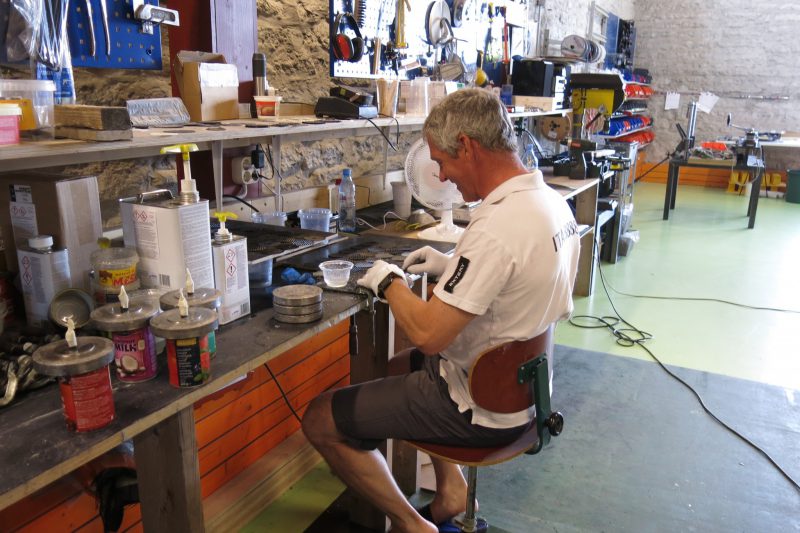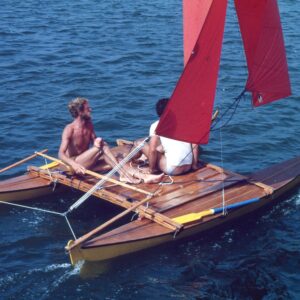Projects: The Innovators – Ropeye
The versatility of WEST SYSTEM epoxy allowed keen sailor Jaanus Tamme to create prototype pulley blocks from a back-pack ‘factory’ whilst attending regattas. Now he has a global distribution network.
Based outside the city of Tallinn, the capital of Estonia, keen racing sailor Jaanus Tamme has developed a remarkable and award-winning range of pulley blocks based on a combination of WEST SYSTEM epoxy, Dyneema rope and carbon fibre laminates. Named Ropeye (with the second ‘e’ dropped to avoid search engines listing an eye complaint) the range has proved so strong and versatile that it has been adopted by many of the key racing yachts in the world. Teams from the America’s Cup through to the Volvo Ocean Race are specifying the products, and they are also selling well to cruising enthusiasts and boat builders. Customers are increasingly drawn to the Ropeye brand as the deck hardware is so easy to fit, and also compliments the look of a boat thanks to the glossy carbon fibre finish.
 The idea first came to Jaanus as he competed in the Mini Transat series, a gruelling sailing event in which single-handed sailors race across the Atlantic in boats of no more than 21ft (7m) in length.
The idea first came to Jaanus as he competed in the Mini Transat series, a gruelling sailing event in which single-handed sailors race across the Atlantic in boats of no more than 21ft (7m) in length.
“I had spent 15 years racing offshore competitively, and own a Mini Transat yacht,” Jaanus said. “This proved the ideal test bed, because Transat sailors rarely have much money. The boats are usually built in a garage by enthusiasts, and outfitted to a tight budget. They are constantly experimenting with systems that must be simple but effective.”
Jaanus was concerned that a modern pulley block has too many potential failure points, and is also relatively heavy. He didn’t like the fact that it needed several bolts to hold it to the deck, so began to experiment with carbon fibre and Dyneema rope as a way to increase the strength and flexibility of the anchor point.

His racing commitments involved a lot of traveling, so whilst away Jaanus booked himself into Air B&B apartments that had everything he needed to create his epoxy laminate prototypes. Key to the whole process was WEST SYSTEM epoxy, which proved highly transportable. The calibrated dispenser pumps made for very accurate mixing.“I chose WEST SYSTEM products for several reasons and continue to use it for large scale production today” he explained. “It is a high quality and consistently dependable product, which is very stable after curing. It is also very easy to use, with a wide range of variations for different applications. But perhaps most important of all, it has a strong brand behind it, which shows me that the company really cares about its products.”
 Jaanus used his mobile factory right through the 2006-2007 race season and the products quickly came together.“My first ideas were a little complicated, so I began a long process of continual refinement,” he said. “I searched for Air B&B apartments with a big kitchen for mixing WEST SYSTEM epoxy, a big oven for curing, and good internet access. I was able to test the prototypes on the Transat yacht during races. I showed the products to other competitors, and orders started to come in.”
Jaanus used his mobile factory right through the 2006-2007 race season and the products quickly came together.“My first ideas were a little complicated, so I began a long process of continual refinement,” he said. “I searched for Air B&B apartments with a big kitchen for mixing WEST SYSTEM epoxy, a big oven for curing, and good internet access. I was able to test the prototypes on the Transat yacht during races. I showed the products to other competitors, and orders started to come in.”

Whilst his rucksack factory was able to cope with a few orders, as more arrived Jaanus knew he would need to invest in a proper factory, with production techniques for hand-finishing each unit. In 2012 he found a two-storey facility near Tallinn’s airport, and began to recruit skilled assemblers.
Technical staff from Bang & Bonsomer, our local WEST SYSTEM Distributors, were invited to see the design and production process in full swing during a visit to Tallin earlier this year and noticed an efficient mix of hand-tools and resin injection techniques, with a constantly evolving programme of R&D. A qualified designer, Jaanus still likes to sketch out his new ideas on paper, but thanks to advanced 3D printing techniques, a product can be bought from concept to working prototype in less than a week.
Apart from the high load bearing capacity of Ropeye products, it is the look of them and their simplicity, that has led to a healthy order book. “I’m crazy about aesthetics,” Jaanus said. “However, an item can still look great if it has no apparent design, but is just naturally functional.” One particularly interesting development has been the Spider block, created by running the sheave across an interlocking ‘web’ of Dyneema. ‘A spider creates a web from a thread that for its diameter is stronger than steel, so we have taken the same principle. The sheave runs suspended on both sides of this web – no metal bearings, nothing to corrode. Dyneema is naturally slippery, so the result is a smooth-running sheave that can handle more tons than ball bearings, whatever the direction of loading.”
Jaanus is keen to keep the company small and efficient, with just 7 people currently involved in the assembly and dispatch process. “The global market is 24-hours,” he said. “It is always a sunny day somewhere, and people want to buy deck gear. I’ve had a lot of investors approach me wanting to greatly expand the business as the products also have a role outside marine. For example, they are being used in Australia for laying underwater pipelines, and also in the construction industry to replace the metal lifting eyes that are set into concrete blocks, and need grinding off afterwards. We are everywhere, from high profile racing yachts to production OEMs. The sales are good, and stable, and we’ve already received a DAME award nomination. But the creative process never stops. It is the feedback from our customers that keeps the ideas coming!”
For more information on the Ropeye brand, which has an interactive website, visit: www.ropeye.com
(Our thanks to IBI Magazine, which carries the full feature).



